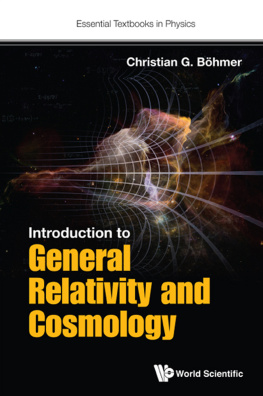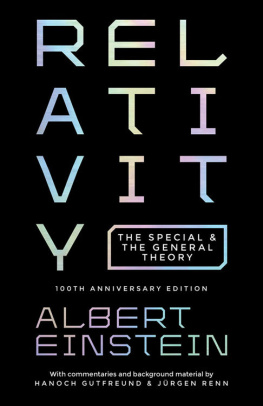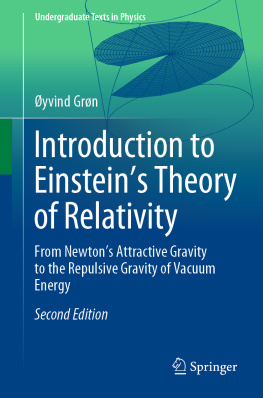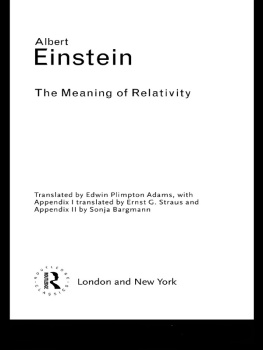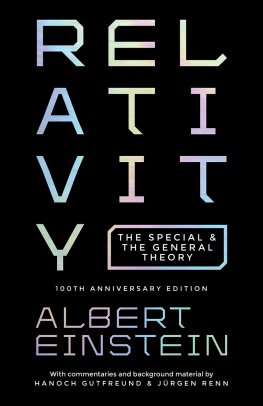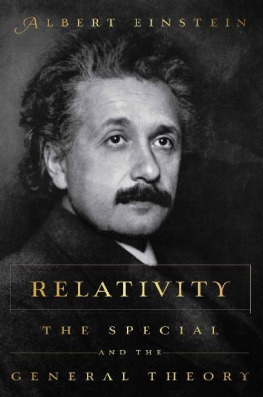Luscombe - Core principles of special and general relativity
Here you can read online Luscombe - Core principles of special and general relativity full text of the book (entire story) in english for free. Download pdf and epub, get meaning, cover and reviews about this ebook. year: 2019, publisher: CRC Press, genre: Computer. Description of the work, (preface) as well as reviews are available. Best literature library LitArk.com created for fans of good reading and offers a wide selection of genres:
Romance novel
Science fiction
Adventure
Detective
Science
History
Home and family
Prose
Art
Politics
Computer
Non-fiction
Religion
Business
Children
Humor
Choose a favorite category and find really read worthwhile books. Enjoy immersion in the world of imagination, feel the emotions of the characters or learn something new for yourself, make an fascinating discovery.

Core principles of special and general relativity: summary, description and annotation
We offer to read an annotation, description, summary or preface (depends on what the author of the book "Core principles of special and general relativity" wrote himself). If you haven't found the necessary information about the book — write in the comments, we will try to find it.
Luscombe: author's other books
Who wrote Core principles of special and general relativity? Find out the surname, the name of the author of the book and a list of all author's works by series.
Core principles of special and general relativity — read online for free the complete book (whole text) full work
Below is the text of the book, divided by pages. System saving the place of the last page read, allows you to conveniently read the book "Core principles of special and general relativity" online for free, without having to search again every time where you left off. Put a bookmark, and you can go to the page where you finished reading at any time.
Font size:
Interval:
Bookmark:
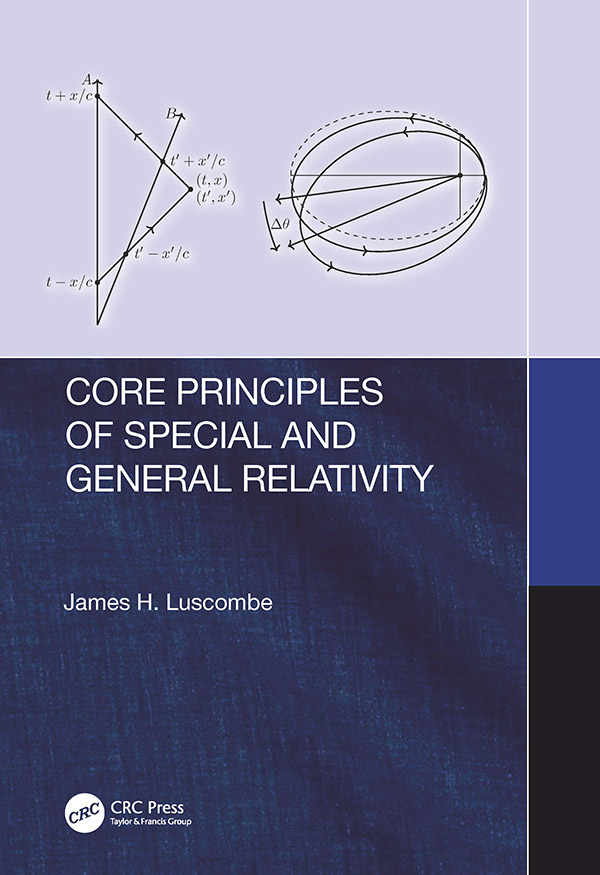
Core Principles of Special and General Relativity
Core Principles of Special and General Relativity
James H. Luscombe

CRC Press
Taylor & Francis Group
6000 Broken Sound Parkway NW, Suite 300
Boca Raton, FL 33487-2742
2019 by Taylor & Francis Group, LLC
CRC Press is an imprint of Taylor & Francis Group, an Informa business
No claim to original U.S. Government works
Printed on acid-free paper
International Standard Book Number-13: 978-1-138-54294-5 (Hardback)
This book contains information obtained from authentic and highly regarded sources. Reasonable efforts have been made to publish reliable data and information, but the author and publisher cannot assume responsibility for the validity of all materials or the consequences of their use. The authors and publishers have attempted to trace the copyright holders of all material reproduced in this publication and apologize to copyright holders if permission to publish in this form has not been obtained. If any copyright material has not been acknowledged please write and let us know so we may rectify in any future reprint.
Except as permitted under U.S. Copyright Law, no part of this book may be reprinted, reproduced, transmitted, or utilized in any form by any electronic, mechanical, or other means, now known or hereafter invented, including photocopying, microfilming, and recording, or in any information storage or retrieval system, without written permission from the publishers.
For permission to photocopy or use material electronically from this work, please access www.copyright.com (http://www.copyright.com/) or contact the Copyright Clearance Center, Inc. (CCC), 222 Rosewood Drive, Danvers, MA 01923, 978-750-8400. CCC is a not-for-profit organization that provides licenses and registration for a variety of users. For organizations that have been granted a photocopy license by the CCC, a separate system of payment has been arranged.
Trademark Notice: Product or corporate names may be trademarks or registered trademarks, and are used only for identification and explanation without intent to infringe.
Visit the Taylor & Francis Web site at
http://www.taylorandfrancis.com
and the CRC Press Web site at
http://www.crcpress.com
Contents
T he theory of relativity is a core component of physics curricula, yet the level at which its taught can differ widely, from minimal coverage of special relativity (SR) in modern physics courses, to treatments using four-vectors in mechanics courses, to covariant treatments of electrodynamics, to graduate courses on general relativity (GR). I have sought to create a text aimed at advanced undergraduate/first-year graduate students, which starts with the foundations of SR and continues through to GR, at roughly the same level of sophistication. What makes that a challenge is the mathematics involved toward the end of the journey. General relativity requires the mathematics of curved spaces, the province of differential geometry. If linear algebra comprises the mathematics of quantum mechanics, differential geometry is the lingua franca of GR, and most physics students learn this branch of mathematics in courses on GR . We start at the beginning developing the mathematics as required with the goal of providing in one voice, hopefully in an accessible style, the full picture of the subject. I assume students have had, or are taking, the standard courses in undergraduate physics curriculaanalytical mechanics, quantum mechanics, electrodynamics, and mathematical methodsbut not dedicated courses in relativity beyond what one encounters in a modern physics course. I assume familiarity with the Michelson-Morley experiment (MM). I do not presuppose a mastery of tensors; we supply a reasonably in-depth treatment of tensors, on flat and curved spaces. There are numerous texts on relativity available, of varying degrees of rigor. I have sought a middle ground between treatments that are qualitative and lacking in mathematical details and works written by experts for experts.
Here are some points of note.
Minus signs : Minus-sign ambiguities arise at several places in relativity. The first is the Lorentz metric. We choose (+++); this seems best (to me)it singles out time as the quantity warranting special treatment, so true in relativity, and it leaves alone the Euclidean metric for spatial variables. Students must learn from the outset that relativity mostly is about time. The perennial debate over the Lorentz metric will not be settled here. Another source of minus sign confusion is in the Riemann curvature tensor R ; I have put the indices associated with derivatives in the third and fourth places, i.e., and . We take the Ricci tensor as the contraction over the first and third indices of the Riemann tensor, R = R . Finally, the energy-momentum tensor is defined so that T 0.
Notation : An attempt has been made at being consistent. Scalar quantities are indicated in italic font: the speed of light, c . Vector quantities are indicated with boldface italic font: force F . Tensors considered as geometric objects are indicated with boldface Roman font: T (this notation doesnt appear until ). Components of tensors are indicated in italic font with indices: T . Tensor densities are indicated with Gothic symbols, ; that notation is sparingly used.
Units : I have kept all the factors of c , G , and in formulas. There is a certain panache in advanced physics of working in units where c = G = 1, etc. The aim of this practice is to: 1) avoid repetitively writing the same old factors, and 2) gain insight into the geometric meaning of formulas. In a firstand perhaps onlyexposure to the subject, I have consistently worked in SI units.
Mathematics : Relativity is a mathematical theory; theres no way around that. Tensors constitute the very language of relativity: An equation of physics expressed as a relation between tensors, if valid in one reference frame, is valid in all reference frames. Yet the mathematical preparation of students in this area is often insufficient for a study of relativity, and the power of the theory cannot be harnessed without knowledge of its mathematical structure. To fill this gap, roughly 25% of the book is devoted to the mathematics of relativity. , if encountered for the first time, would be daunting despite my attempts to guide you through the maze. It takes time to become proficient in the theory of relativity, to learn its methods and scope. Physics students tend to learn mathematics on a need-to-know basis, and most learn this material in courses on GR. Physicists often find themselves strangers in a strange land of mathematics.
Organization : concludes with a brief introduction to cosmology. Appendices contain specialized topics.
History : I have reproduced passages from the writings of Newton, Einstein, Minkowski, and others. Its instructive for students to see how the luminaries of physics have grappled with the very subject they are encountering. No attempt has been made to offer a history of relativity.
Going outside the box : Relativity is foundational to much of physics. The book is offered against the backdrop of the corpus of physical theory, to which the student is assumed to have had exposure. When instructive I point out parallels with other branches of physics; I do not pretend that other parts of physics dont exist.
Disclaimers : In addition to typos and outright blunders, I welcome comments on what is not clear . Invariably, when delving into a subject with sufficient depth you get hot on the material, and many conclusions seem obvious. Later, however, they may not be so obvious. I have attempted to give all the details necessary to derive the important equations. If the presentation seems ploddingly slow at times, Ive succeeded in bringing you up to speed. Its all relative!
Font size:
Interval:
Bookmark:
Similar books «Core principles of special and general relativity»
Look at similar books to Core principles of special and general relativity. We have selected literature similar in name and meaning in the hope of providing readers with more options to find new, interesting, not yet read works.
Discussion, reviews of the book Core principles of special and general relativity and just readers' own opinions. Leave your comments, write what you think about the work, its meaning or the main characters. Specify what exactly you liked and what you didn't like, and why you think so.


